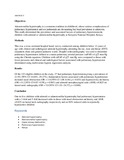| dc.contributor.author | Nduati, Ruth | |
| dc.contributor.author | Wambani, Sidika | |
| dc.contributor.author | Aswani, Joyce | |
| dc.contributor.author | Jowi, Christine | |
| dc.contributor.author | Marangu, Diana | |
| dc.date.accessioned | 2014-07-15T11:43:05Z | |
| dc.date.available | 2014-07-15T11:43:05Z | |
| dc.date.issued | 2014 | |
| dc.identifier.citation | International Journal of Pediatric Otorhinolaryngology Volume 78, Issue 8, August 2014, Pages 1381–1386 | en_US |
| dc.identifier.uri | http://www.sciencedirect.com/science/article/pii/S0165587614003309 | |
| dc.identifier.uri | http://hdl.handle.net/11295/73024 | |
| dc.description.abstract | Objectives
Adenotonsillar hypertrophy is a common condition in childhood, whose serious complications of pulmonary hypertension and cor pulmonale are devastating but local prevalence is unknown. This study determined the prevalence and associated factors of pulmonary hypertension in children with adenoid or adenotonsillar hypertrophy at Kenyatta National Hospital, Kenya.
Methods
This was a cross sectional hospital based survey conducted among children below 12 years of age with clinical and radiological adenoid hypertrophy attending the ear, nose and throat (ENT) outpatient clinic and general pediatric wards. Doppler echocardiography was used to determine pulmonary hypertension defined as a mean pulmonary arterial pressure (mPAP) of ≥25 mm Hg using the Chemla equation. Children with mPAP of ≥25 mm Hg were compared to those with lower pressures and clinical and radiological factors associated with pulmonary hypertension determined using multivariate logistic regression analysis.
Results
Of the 123 eligible children in the study, 27 had pulmonary hypertension giving a prevalence of 21.9% (95% CI 14.64%–29.27%). Independent factors associated with pulmonary hypertension included nasal obstruction (OR = 3.0 [95% CI 1.08–8.44] p = 0.035) and hyperactivity on history (OR = 0.2 [95% CI 0.07–0.59] p = 0.003) and adenoid-nasopharyngeal ratio (ANR) >0.825 on lateral neck radiography (OR = 5.0 [95% CI 1.01–24.37] p = 0.048).
Conclusion
One in five children with adenoid or adenotonsillar hypertrophy had pulmonary hypertension with a 3-fold and 5-fold increased odds in those with nasal obstruction on history and ANR >0.825 on lateral neck radiography respectively and an 80% reduced odds in reportedly hyperactive children.
Keywords
Adenoid hypertrophy;
Adenotonsillar hypertrophy;
Upper airway obstruction;
Pulmonary hypertension;
Kenya | en_US |
| dc.language.iso | en | en_US |
| dc.publisher | University of Nairobi | en_US |
| dc.title | Prevalence and associated factors of pulmonary hypertension in Kenyan children with adenoid or adenotonsillar hypertrophy | en_US |
| dc.type | Article | en_US |
| dc.type.material | en | en_US |

